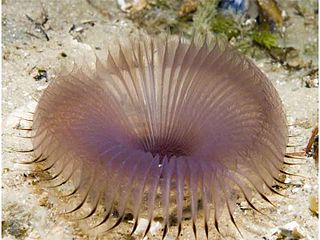
Polychaeta is a paraphyletic class of generally marine annelid worms, commonly called bristle worms or polychaetes. Each body segment has a pair of fleshy protrusions called parapodia that bear many bristles, called chaetae, which are made of chitin. More than 10,000 species are described in this class. Common representatives include the lugworm and the sandworm or clam worm Alitta.

Eunicidae is a family of marine polychaetes. The family comprises marine annelids distributed in diverse benthic habitats across Oceania, Europe, South America, North America, Asia and Africa. The Eunicid anatomy typically consists of a pair of appendages near the mouth (mandibles) and complex sets of muscular structures on the head (maxillae) in an eversible pharynx. One of the most conspicuous of the eunicids is the giant, dark-purple, iridescent "Bobbit worm", a bristle worm found at low tide under boulders on southern Australian shores. Its robust, muscular body can be as long as 2 m. Eunicidae jaws are known from as far back as Ordovician sediments. Cultural tradition surrounds Palola worm reproductive cycles in the South Pacific Islands. Eunicidae are economically valuable as bait in both recreational and commercial fishing. Commercial bait-farming of Eunicidae can have adverse ecological impacts. Bait-farming can deplete worm and associated fauna population numbers, damage local intertidal environments and introduce alien species to local aquatic ecosystems.

Sabellidae, or feather duster worms, are a family of marine polychaete tube worms characterized by protruding feathery branchiae. Sabellids build tubes out of a tough, parchment-like exudate, strengthened with sand and bits of shell. Unlike the other sabellids, the genus Glomerula secretes a tube of calcium carbonate instead. Sabellidae can be found in subtidal habitats around the world. Their oldest fossils are known from the Early Jurassic.

Canalipalpata, also known as bristle-footed annelids or fan-head worms, is an order of polychaete worms, with 31 families in it including the suborder Sabellida (families Serpulidae and Sabellidae and the Alvinellidae, a family of deep-sea worms associated with hydrothermal vents.

Serpula is a genus of sessile, marine annelid tube worms that belongs to the family Serpulidae. Serpulid worms are very similar to tube worms of the closely related sabellid family, except that the former possess a cartilaginous operculum that occludes the entrance to their protective tube after the animal has withdrawn into it. The most distinctive feature of worms of the genus Serpula is their colorful fan-shaped "crown". The crown, used by these animals for respiration and alimentation, is the structure that is most commonly seen by scuba divers and other casual observers.

A radiole is a heavily ciliated feather-like tentacle found in highly organized clusters on the crowns of Canalipalpata. Canalipalpata is an order of sessile marine polychaete worms consisting of 31 families. These benthic annelid tube worms employ radioles primarily for alimentation. While their primary role is to function as an organ for filter feeding, radioles also serve as respiratory organs. Because of their role in gas exchange, radioles are often referred to as "gills".
Scleroplax is a genus of crabs in the family Pinnotheridae.

Sabellastarte spectabilis is a species of benthic marine polychaete worm in the Sabellidae family. It is commonly known as the feather duster worm, feather duster or fan worm. It is native to tropical waters of the Indo-Pacific but has spread to other parts of the world. It is popular in aquariums because of its distinctive appearance and its ability to remove organic particles and improve water quality.
Defretinella is a genus of parasitic alveolates of the phylum Apicomplexa.
Kirk J. Fitzhugh is the curator at the Natural History Museum of Los Angeles County, a position he has held since 1990. His research focuses on the systematics of polychaetes and on the philosophical foundations of evolutionary theory. Fitzhugh is a critic of DNA barcoding methods as a technical substitute for systematics. He attends Willi Hennig Society meetings where he has argued that "synapomorphy as evidence does not meet the scientific standard of independence...a particularly serious challenge to phylogenetic systematics, because it denies that the most severely tested and least disconfirmed cladogram can also maximize explanatory power." His graduate supervisor was V. A. Funk, from the U.S. National Herbarium, National Museum of Natural History, Smithsonian Institution MRC. He completed his doctoral thesis on Systematics and phylogeny of Sabellid polychaetes in 1988 while he was a research scientist at the LA County museum He married a lawyer named Nancy E. Gold in 1989.
Pettais a genus in the polychaetefamily Pectinariidae.

Sabellastarte is a genus of marine polychaete worms in the family Sabellidae.

Myxicola infundibulum is a species of polychaete worm from the family Sabellidae. The body consists of a head, a cylindrical, segmented body and a tail piece. The head consists of a Prostomium and a peristomium and carries paired appendages.

Pygospio is a genus of marine polychaete worms in the family Spionidae.
Jasmineira elegans is a macrobenthic suspension feeder native to the coastal waters of the Northern Atlantic, Mediterranean Sea, and Red Sea. The worm is sessile and lives in sandy substrates where it utilizes suspension feeding in order to acquire nutrients.

Acromegalomma interruptum is a bristle worm from the Sabellidae family. The body of the worm consists of a head, a cylindrical, segmented body and a tailpiece. The head consists of a prostomium and a peristomium and carries paired appendages.
Fauveliopsidae is a family of polychaetes belonging to the order Terebellida. The genus name honours Pierre Fauvel.

Myxicola is a genus of polychaetes belonging to the family Sabellidae.
Gunnarea is a monotypic genus of polychaete worms in the family Sabellariidae, first described by Karl Eric Johansson, in 1927. The type taxon is Hermella capensis Schmarda, 1861 now accepted as syn. Gunnarea gaimardi.










